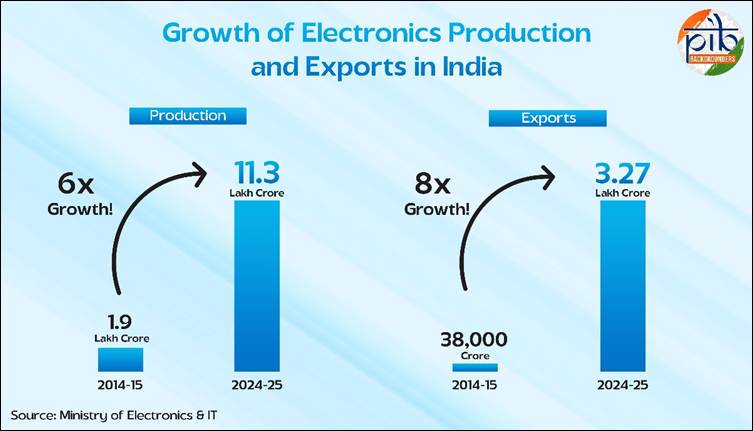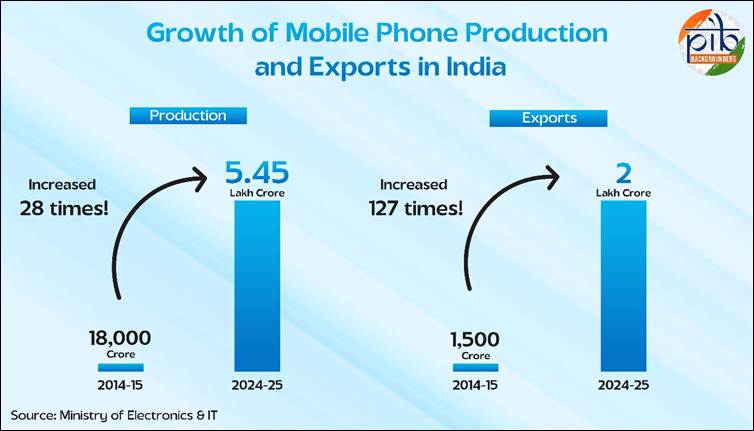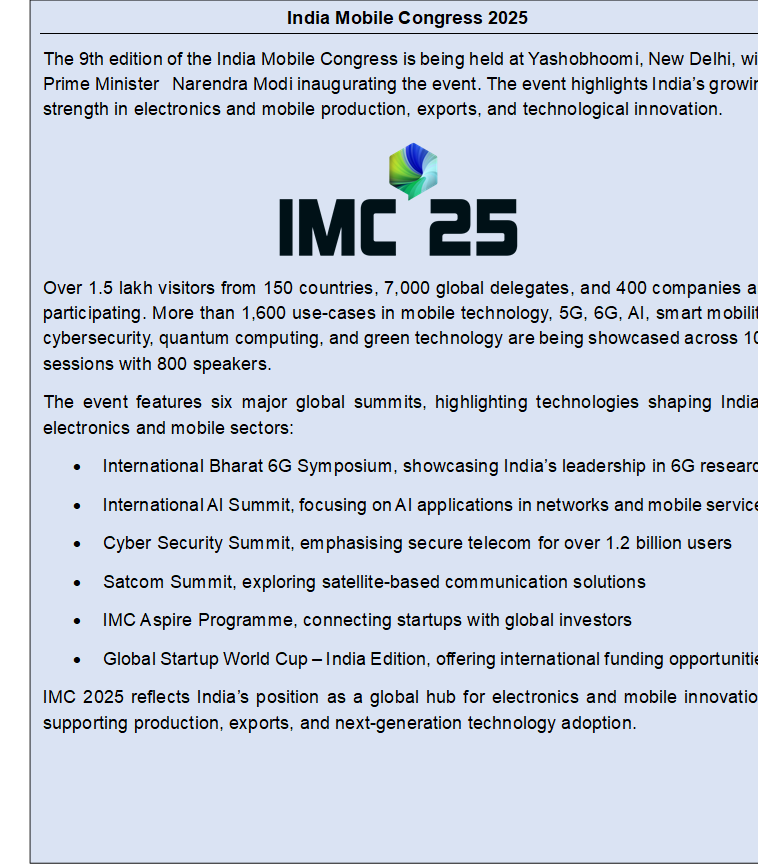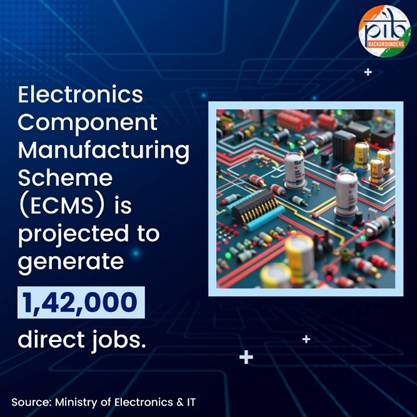PIB Headquarters
India’s Electronics Leap
Production soars to ₹11.3 lakh crore in 2024–25, six-fold over the decade
Posted On:
11 OCT 2025 2:23PM by PIB Delhi
|
Key Takeaways
- Electronics production increased nearly six-fold from ₹1.9 lakh crore in 2014–15 to ₹11.3 lakh crore in 2024–25.
- Mobile phone exports rose 127 times from ₹1,500 crore in 2014–15 to ₹2 lakh crore in 2024–25.
- India is the world’s second-largest mobile phone manufacturer.
- Electronics manufacturing created 25 lakh jobs in the last 10 years.
|
Introduction
Electronics has become the engine of innovation and growth, powering economies and redefining the technological landscape. Across the world, the sector is driving advancements in communication, automation, and connectivity, shaping how societies live, work, and interact.
India has rapidly transformed into a major electronics manufacturing hub, marking nearly a six-fold increase in production over the past decade. The sector has not only expanded its industrial base but also created 25 lakh jobs in the last 10 years, underscoring its role as a key driver of employment and economic growth. Strategic government initiatives and strong policy support have further boosted local manufacturing, expanded exports, and attracted significant global investment.
With the ambitious vision of building a $500 billion domestic electronics manufacturing ecosystem by 2030–31, India is poised to emerge as a global technology leader, innovating for the world while creating vast opportunities at home.
Electronics Production and Exports Landscape
India has rapidly transformed into a global hub for electronics manufacturing, driven by initiatives like Make in India and Atmanirbhar Bharat. Strong policy support, technological advancements, and a skilled workforce have propelled both production and exports to unprecedented levels.
Key Achievements:
- Electronics production increased from ₹1.9 lakh crore in 2014–15 to ₹11.3 lakh crore in 2024–25, nearly a six-fold rise.
- Exports grew eight times from ₹38,000 crore to ₹3.27 lakh crore during the same period.
- In the last 10 years, electronics manufacturing in India has created 25 lakh jobs.[1]
- India has attracted more than USD 4 billion FDI Inflow in the field of electronics manufacturing since FY2020-21.
- Top 5 export destinations for Indian electronic goods in FY 2024–25 are the United States, United Arab Emirates, the Netherlands, the United Kingdom, and Italy.

Supportive measures such as the Production Linked Incentive (PLI) scheme and improvements in ease of doing business have significantly boosted manufacturing and exports. The rapid growth in electronics production has created substantial employment opportunities across the country, while India’s electronics sector has become deeply integrated into global supply chains, enhancing competitiveness and attracting foreign investment.
Mobile Manufacturing and Exports
India’s mobile phone revolution is reshaping lives and livelihoods. With over 85 per cent of Indian households owning at least one smartphone, the device today serves as a tool for banking, education, entertainment, and access to government services. Mobile connectivity has become a powerful driver of financial inclusion and digital empowerment, making India one of the most connected societies in the world.

Key Achievements:
- Mobile phone production increased from ₹18,000 crore in 2014–15 to ₹5.45 lakh crore in 2024–25, a 28-fold rise.
- India has become the world’s second-largest mobile phone manufacturer
- India’s mobile manufacturing industry has scaled rapidly- from just 2 units in 2014 to over 300 units today.
- Around 330 million mobile phones are produced annually, with nearly a billion devices in active use nationwide.
- Exports surged 127 times, from ₹1,500 crore in 2014–15 to ₹2 lakh crore in 2024–25.
- In 2024, Apple exports from India hit a record ₹1,10,989 crore (US$12.8 billion), crossing the ₹1 lakh crore mark with a 42% YoY growth.
- In just the first five months of FY 2025–26, smartphone exports reached ₹1 lakh crore, a 55% increase over the same period last year.
- India has achieved near self-reliance in mobile production- from importing 78% of its requirements in 2014–15 to manufacturing almost all devices domestically today.
- In Q2 FY 2025-26, India overtook China to become the top smartphone exporter to the United States.

Electronics as the Backbone of Modern Industries[3]
Electronics form the backbone of the modern economy. From homes to hospitals, and from factories to vehicles, they enable efficiency, comfort and innovation. Every major sector today relies on electronics to improve performance, enhance safety and deliver better services. As technology evolves, the importance of electronics in driving progress across industries continues to grow.
Some sectors where electronics play a big role are outlined below:
Consumer Electronics
Consumer electronics have become an inseparable part of daily life. Every household now depends on devices such as televisions, refrigerators, air conditioners and washing machines. These products bring convenience, entertainment and efficiency to homes. The growing affordability and variety of consumer gadgets reflect the expanding role of electronics in improving the quality of life for millions.
Electronic Components
Electronic components are the foundation of the entire electronics ecosystem. They power every device, from a simple home appliance to complex industrial systems. No manufacturer can produce consumer electronics, defence systems or medical devices without these essential parts. The strength of this sub-sector determines the overall resilience and competitiveness of the electronics industry.
Automotive Electronics
Modern vehicles are increasingly dependent on electronics for performance, safety and connectivity. As the world shifts towards electric and smart mobility, the demand for automotive electronics is rising sharply. Urbanisation and the growing need for cleaner transport are accelerating this change. From sensors to infotainment systems, electronics are transforming how vehicles operate and interact with users.
Medical Electronics
The rise in lifestyle-related illnesses and the growing demand for healthcare services have expanded the market for medical electronics. Devices such as oximeters, glucometers and digital monitors are now common in households and hospitals alike. Innovation in medical technology is improving diagnosis, treatment and patient care. Electronics have made healthcare more accessible, accurate and responsive to the needs of a changing world.
Key Government Initiatives for Electronics Manufacturing
India’s electronics industry has grown on the back of strong policy support and targeted government initiatives. These programmes aim to build a globally competitive manufacturing ecosystem, attract investment, and create large-scale employment while strengthening India’s role in global value chains.
Production-Linked Incentive (PLI) Scheme[4]
The Production-Linked Incentive Scheme, with an outlay of ₹1.97 lakh crore, spans 14 key sectors including electronics and IT hardware. It encourages companies to boost production, adopt new technologies, and expand exports.

As mentioned earlier, India has attracted more than USD 4 billion FDI Inflow in the field of electronics manufacturing since FY2020-21. Nearly 70% of this FDI is contributed by the beneficiaries of PLI Scheme.
Scheme for Promotion of Manufacturing of Electronic Components and Semiconductors (SPECS)[5]
The SPECS scheme offers a 25 percent financial incentive on capital expenditure for producing key electronic goods. It helps bridge critical supply chain gaps, encourages local production, and supports India’s transition from assembly-based manufacturing to high-value component manufacturing.
Electronics Components Manufacturing Scheme (ECMS)[6]
The ECMS, approved by the Cabinet on 1st May 2025 with a fiscal outlay of ₹22,919 crore, has received 249 applications, signalling strong industry interest. The anticipated investment commitment of ₹1,15,351 crore is nearly double the original target of ₹59,350 crore.

The scheme is expected to generate production worth ₹10,34,700 crore over the next six years, which is 2.2 times the initial target of ₹4,56,000 crore. It is projected to create 1,42,000 direct jobs, far exceeding the target of 91,600, along with a manifold number of indirect jobs. This demonstrates the scheme’s potential to drive large-scale employment and economic growth.
The overwhelming response reflects India’s growing stature on the global stage and rising confidence in the domestic electronics industry, including MSMEs. The initial application window of three months, starting 1st May 2025, was extended till 30th September 2025. ECMS is expected to accelerate India’s journey towards the Prime Minister’s vision of a $500 billion domestic electronics manufacturing ecosystem by 2030-31.
National Policy on Electronics (NPE) 2019
The National Policy on Electronics aims to position India as a global hub for Electronics System Design and Manufacturing (ESDM). It envisions achieving $400 billion in revenue from ESDM by 2025. The policy promotes innovation, encourages design-led manufacturing, and supports research and development to ensure long-term industry growth.
Conclusion
India’s electronics and mobile manufacturing journey reflects ambition, innovation, and global competitiveness. Schemes such as the Production-Linked Incentive (PLI), Electronics Components Manufacturing Scheme (ECMS), and the Scheme for Promotion of Manufacturing of Electronic Components and Semiconductors (SPECS) have propelled domestic production, strengthened supply chains, and boosted exports. Combined with the National Policy on Electronics and initiatives under Make in India, these measures have generated employment, attracted investment, and enhanced India’s technological self-reliance. With sustained innovation and policy support, the country is poised to achieve a $500 billion domestic electronics ecosystem by 2030-31 and secure its position as a global leader in electronics and mobile technology.
References:
PIB Backgrounders:
Ministry of Electronics & IT:
Ministry of Communications:
Ministry of MSME:
Ministry of Commerce and Industry:
Click here to see pdf
***
VV/SA
(Release ID: 2177755)
Visitor Counter : 5766